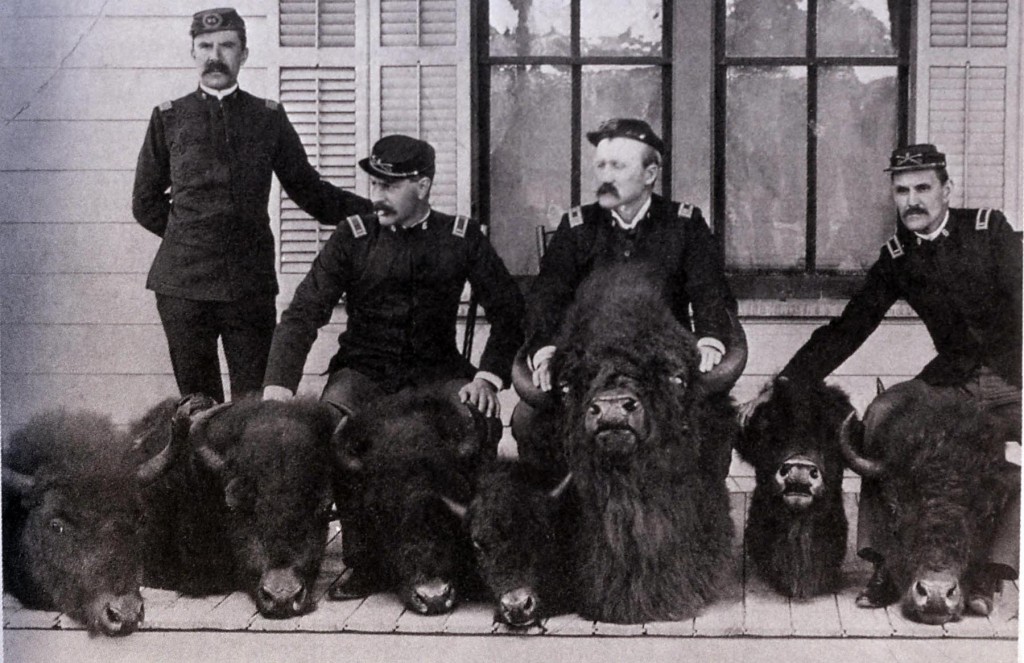
- The U.S. Army played a key role in the early history of Yellowstone National Park. Members of the U.S. Army’s 6th Cavalry pose with buffalo heads seized in 1894 from Cooke City poacher Edgar Howell. (NPS photo)
In 1886, the U.S. Army took on the perhaps incongruent assignment of protecting Yellowstone National Park from the commercial instincts of an expanding capitalist country — a task contrary to its more traditional work of establishing settlements, fighting Indians and essentially providing the hoofbeat of manifest destiny. The latter concept, though, was meant to be vacated in the park. But in the decade or so after Yellowstone’s creation, the original protectionist directive there was being eroded by a combination of politics, opportunism and neglect. It became the Army’s obligation to turn things around.
The Army played a key role in the early history of Yellowstone. The Army had accompanied various expeditions in the 1860s and 1870s, and having chased the Nez Perce Indians through the area on the tribe’s flight to Canada. But the military had never before been placed in charge of directly enforcing rules that would conserve natural resources for all.
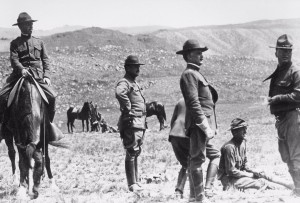
U.S. Army soldiers follow the action at a firing range in Yellowstone Park in an undated archival photo. (NPS photo)
In 1882, Gen. Philip Sheridan visited the park from the south — carving a useful trail from Jackson Hole to Yellowstone Lake — and generally enjoying himself, as described by former park historian Aubrey Haines in his authoritative history of Yellowstone, “The Yellowstone Story: A History of Our First National Park.”
But on his way home along the construction of the Northern Pacific Railroad near Billings, Mont., Sheridan discovered things in the Park were not as he believed.
“I regretted exceedingly to learn,” he wrote, “that the national park had been rented out to private parties.”
Sheridan’s reference was to the deceptively named Yellowstone Park Improvement Company, a group of 19th-century monopolists set on exclusive control of tourist accommodations and extensive tracts of Park land. While that company went bankrupt for its own blunderings, others were ready to follow, often with the acquiescence of civilian administrators, one of whom noted that “the park was created to be an instrument of profit to those who were shrewd enough to grasp the opportunity.”
While private national interests were moving in from the east, a good number of local residents were taking from the park whatever they could get away with. Poaching was common in the early history of Yellowstone, accounting for the deaths of some 4,000 elk in the Mammoth Hot Springs basin in a single year, according to Haines. Some of the more resourceful entrepreneurs took as many as 25 to 50 elk per day when the snow was deep enough to slow the animals’ travel.
Various squatters had taken virtual ownership of land, unauthorized firewood cutting had leveled wide stretches of Park timber and Cooke City residents were supplying themselves with large catches of illegal fish. Meanwhile, tourists carved off chunks of hot springs and “soaped” geysers — a practice accidentally discovered in 1885 by a Chinese laundry worker, and later used regularly to enhance or hasten an eruption.
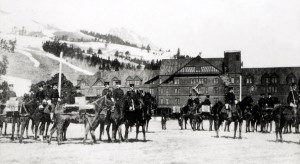
An undated archival photo shows a U.S. Army machine gun platoon at Fort Yellowstone, now Mammoth Hot Springs. (NPS Photo)
Reign of Moses
All this would come to an end with the Army, beginning under Capt. Moses Harris. His commandments to his troops required, among other things, that they halt all trapping, hunting (including, for the first time, predators) and fishing, “except with hook and line.” For the first time in the history of Yellowstone, Harris halted the sale of alcohol except by authorized hotels to their guests, and stopped tourists from throwing rocks, sticks and other debris into geyser cones. The troops doggedly guarded geysers from specimen gatherers, leading one British traveler to note that the appearance of a soldier caused tourists to “instinctively put their hands behind their backs, or guiltily move in an opposite direction.”
Based out of Camp Sheridan (later Fort Yellowstone) at Mammoth Hot Springs and in various backcountry establishments, the Army curtailed poaching and expelled people from the Park with a mandate not wielded by any previous authority. While Army regulars managed the park on the ground, Sheridan took on the big monopolists when he opened the first Yellowstone “war,” by convincing the secretary of the interior to forbid any railroad within Park boundaries. It was a pitched battle in the early history of Yellowstone that was eventually won by the anti-railroad forces.
The Army’s methods often met with criticism from area residents (and a creative local press) who believed the Army to be overzealous. Haines writes that one newspaper, arguing that the Army’s protection of wildlife was leading to overpopulation, submitted the following:
Ananias Anderson is Captain of the Guard,
He patrols the National Reserve, he guards the U.S. yard;
And ‘neath his magnifying eyes and multiplying tongue,
The increased herds of game are more than when the world was young.
The soldiers’ work was difficult and dangerous, particularly in winter, when they would patrol on skis. Soldiers were lost to avalanches and cold weather, and some were killed by poachers.
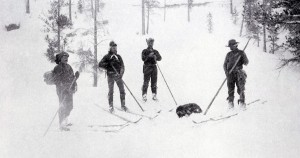
Members of the U.S. Army and poacher Ed Howell stand at the site near Pelican Creek in Yellowstone National Park where he was captured in 1894. (NPS Photo)
Famous capture
Perhaps the most famous Army capture in the history of Yellowstone was of the infamous Cooke City poacher, Edgar Howell, in the winter of 1894. In March, Army regulars caught Howell in the act of killing buffalo on Pelican Creek for their $300 scalps. Snow and high winds protected the troops’ approach across some 200 yards of open country, and Howell was easily subdued. He noted, however, that they never would have taken him had he seen them first, and made good on the suggestion by trying to kill the dog that failed to warn him.
While escorting Howell to the guardhouse in Mammoth, the troops coincidentally came upon news correspondent Emerson Hough. Howell bragged that his punishment would be light: expulsion from the park and the loss of less than $30 worth of gear. Hough and photographer Frank Haynes dispatched a story and photos of the Howell capture to New York City, where it made great press.
Through the help of Forest and Stream editor George Bird Grinnell, the story generated legislation from Rep. John F. Lacey, adopted within weeks of the incident as the Lacey Act, a far-reaching wildlife protection law which provided the Army with the additional law enforcement authority needed to successfully prosecute criminals, rather than simply expel them.
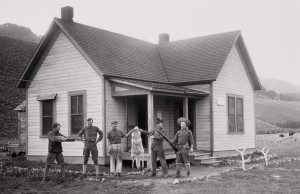
U.S. Army soldiers at the Soda Butte Soldier Station display a wolf pelt in a 1905 archival photo. (NPS Photo)
Howell, having been merely expelled prior to the act, showed up again the next summer in a barber’s chair in Mammoth, from which he was immediately arrested and jailed under the new law. Howell was apparently a character — and not all bad. Through some “quirk of his nature,” as Haines notes in his history of Yellowstone, Howell was proud of his role in generating the new laws, and was eventually even hired as a detective in the park, becoming instrumental in the later capture of stagecoach bandits. Some sources claim that, after his Yellowstone days, Howell moved to the Philippines, where he ran a restaurant.
The National Park Service was established in 1916, and by 1918 had taken over control of Yellowstone from the Army.
The Army regulars in Yellowstone were generally a coarse bunch, trained on the vast western plains, and at a monthly salary of $13, they were motivated less by pay than by “the tug of adventure.” While less than scientific in their methods — extinguishing every forest fire they found, stocking non-native fish like black bass and playing a role in the domestication of buffalo on the Lamar River — they nonetheless established the protective cover the park needed at the time to maintain its integrity as a preserve for nature and a playground for the public.
Jim Davis is a former reporter and hunting guide living in Cody, Wyo. As deputy county attorney, he represents Park County on issues related to Yellowstone Park, but does not report on them for Yellowstone Gate.
